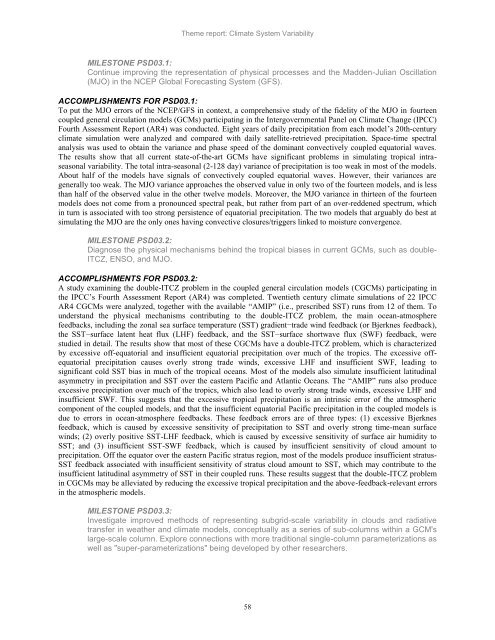Scientific Theme: Advanced Modeling and Observing Systems
Scientific Theme: Advanced Modeling and Observing Systems
Scientific Theme: Advanced Modeling and Observing Systems
Create successful ePaper yourself
Turn your PDF publications into a flip-book with our unique Google optimized e-Paper software.
<strong>Theme</strong> report: Climate System Variability<br />
MILESTONE PSD03.1:<br />
Continue improving the representation of physical processes <strong>and</strong> the Madden-Julian Oscillation<br />
(MJO) in the NCEP Global Forecasting System (GFS).<br />
ACCOMPLISHMENTS FOR PSD03.1:<br />
To put the MJO errors of the NCEP/GFS in context, a comprehensive study of the fidelity of the MJO in fourteen<br />
coupled general circulation models (GCMs) participating in the Intergovernmental Panel on Climate Change (IPCC)<br />
Fourth Assessment Report (AR4) was conducted. Eight years of daily precipitation from each model‘s 20th-century<br />
climate simulation were analyzed <strong>and</strong> compared with daily satellite-retrieved precipitation. Space-time spectral<br />
analysis was used to obtain the variance <strong>and</strong> phase speed of the dominant convectively coupled equatorial waves.<br />
The results show that all current state-of-the-art GCMs have significant problems in simulating tropical intraseasonal<br />
variability. The total intra-seasonal (2-128 day) variance of precipitation is too weak in most of the models.<br />
About half of the models have signals of convectively coupled equatorial waves. However, their variances are<br />
generally too weak. The MJO variance approaches the observed value in only two of the fourteen models, <strong>and</strong> is less<br />
than half of the observed value in the other twelve models. Moreover, the MJO variance in thirteen of the fourteen<br />
models does not come from a pronounced spectral peak, but rather from part of an over-reddened spectrum, which<br />
in turn is associated with too strong persistence of equatorial precipitation. The two models that arguably do best at<br />
simulating the MJO are the only ones having convective closures/triggers linked to moisture convergence.<br />
MILESTONE PSD03.2:<br />
Diagnose the physical mechanisms behind the tropical biases in current GCMs, such as double-<br />
ITCZ, ENSO, <strong>and</strong> MJO.<br />
ACCOMPLISHMENTS FOR PSD03.2:<br />
A study examining the double-ITCZ problem in the coupled general circulation models (CGCMs) participating in<br />
the IPCC‘s Fourth Assessment Report (AR4) was completed. Twentieth century climate simulations of 22 IPCC<br />
AR4 CGCMs were analyzed, together with the available ―AMIP‖ (i.e., prescribed SST) runs from 12 of them. To<br />
underst<strong>and</strong> the physical mechanisms contributing to the double-ITCZ problem, the main ocean-atmosphere<br />
feedbacks, including the zonal sea surface temperature (SST) gradient−trade wind feedback (or Bjerknes feedback),<br />
the SST−surface latent heat flux (LHF) feedback, <strong>and</strong> the SST−surface shortwave flux (SWF) feedback, were<br />
studied in detail. The results show that most of these CGCMs have a double-ITCZ problem, which is characterized<br />
by excessive off-equatorial <strong>and</strong> insufficient equatorial precipitation over much of the tropics. The excessive offequatorial<br />
precipitation causes overly strong trade winds, excessive LHF <strong>and</strong> insufficient SWF, leading to<br />
significant cold SST bias in much of the tropical oceans. Most of the models also simulate insufficient latitudinal<br />
asymmetry in precipitation <strong>and</strong> SST over the eastern Pacific <strong>and</strong> Atlantic Oceans. The ―AMIP‖ runs also produce<br />
excessive precipitation over much of the tropics, which also lead to overly strong trade winds, excessive LHF <strong>and</strong><br />
insufficient SWF. This suggests that the excessive tropical precipitation is an intrinsic error of the atmospheric<br />
component of the coupled models, <strong>and</strong> that the insufficient equatorial Pacific precipitation in the coupled models is<br />
due to errors in ocean-atmosphere feedbacks. These feedback errors are of three types: (1) excessive Bjerknes<br />
feedback, which is caused by excessive sensitivity of precipitation to SST <strong>and</strong> overly strong time-mean surface<br />
winds; (2) overly positive SST-LHF feedback, which is caused by excessive sensitivity of surface air humidity to<br />
SST; <strong>and</strong> (3) insufficient SST-SWF feedback, which is caused by insufficient sensitivity of cloud amount to<br />
precipitation. Off the equator over the eastern Pacific stratus region, most of the models produce insufficient stratus-<br />
SST feedback associated with insufficient sensitivity of stratus cloud amount to SST, which may contribute to the<br />
insufficient latitudinal asymmetry of SST in their coupled runs. These results suggest that the double-ITCZ problem<br />
in CGCMs may be alleviated by reducing the excessive tropical precipitation <strong>and</strong> the above-feedback-relevant errors<br />
in the atmospheric models.<br />
MILESTONE PSD03.3:<br />
Investigate improved methods of representing subgrid-scale variability in clouds <strong>and</strong> radiative<br />
transfer in weather <strong>and</strong> climate models, conceptually as a series of sub-columns within a GCM's<br />
large-scale column. Explore connections with more traditional single-column parameterizations as<br />
well as "super-parameterizations" being developed by other researchers.<br />
58
















